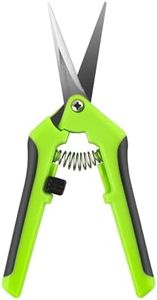We Use CookiesWe use cookies to enhance the security, performance,
functionality and for analytical and promotional activities. By continuing to browse this site you
are agreeing to our privacy policy
5 Best Scissors For Arthritic Hands
From leading brands and best sellers available on the web.Buying Guide for the Best Scissors For Arthritic Hands
When shopping for scissors specifically designed for arthritic hands, comfort and safety should be your two main concerns. Many standard scissors can be difficult to use if you have limited hand strength, joint pain, or reduced dexterity. Look for an option that requires less force to use, fits naturally in your hand, and reduces strain, so you can enjoy crafting, cooking, or everyday tasks with more confidence and less discomfort.Handle DesignThe handle design refers to the shape, size, and material of the part you hold when using the scissors. For people with arthritic hands, a comfortable handle that's contoured and cushioned makes a big difference as it reduces pressure on the joints and is easier to grip. Some handles are looped or have large openings to accommodate swollen joints or reduced flexibility. When evaluating handle designs, consider whether a straight or ergonomic (curved) handle fits better in your hand and look for padded or silicone coatings for extra comfort.
Spring-Assist MechanismA spring-assist mechanism means the scissors automatically reopen after each cut, reducing the effort required from your hand. This feature is particularly useful if you have limited hand strength, stiff joints, or fatigue quickly. Spring-assisted scissors often come in two forms: built-in flexible springs or removable attachments. If you tend to struggle with keeping scissors open or experience hand cramping, choosing a model with a reliable spring-assist can make cutting easier and more comfortable.
Blade Type and SharpnessThe type and sharpness of the blades determine how easily the scissors cut through different materials. Blades that are sharp and made of durable materials like stainless steel require less force, making them ideal for arthritic hands. Some scissors designed for medical or adaptive use feature micro-serrated blades, which grip materials better and make controlled cutting easier. If you plan to use the scissors for paper, fabric, or lightweight tasks, most blade types will suffice — but for tougher materials or precision work, sharper, high-quality blades are preferable.
Weight and SizeThe weight and size of the scissors impact how easy they are to maneuver and hold. Lighter scissors are easier to control, especially if you have limited strength, but they still need to be sturdy enough for the tasks you plan to undertake. The overall length and size of the handles also matter — smaller hands may benefit from compact designs, while larger hands or swollen joints need more spacious handles. Choose a size and weight that feels balanced and comfortable to hold for longer periods without causing extra strain.
Locking Safety MechanismA locking safety mechanism is a feature that keeps the blades closed and secure when not in use. This is not only important for safety, particularly if you have grandchildren or pets around, but also helpful for storage convenience. For those with arthritic hands, an easy-to-use lock that doesn't require a lot of dexterity is key — avoid complicated or stiff locking mechanisms, and look for models with simple push-button or slide locks that you can operate easily.




